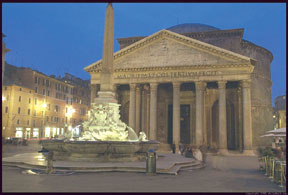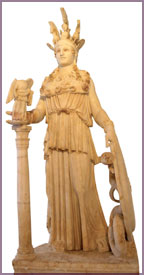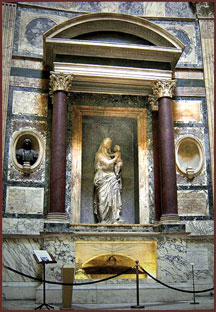
Parthenon and Pantheon:
Two monuments of ancient majesty
Ruwini JAYAWARDANA
The mystique quality and the grandeur behind ancient architecture
continues to mesmerize masses of audience from around the world.
|

A close up of the Parthenon |
Many told and untold tales lie hidden behind the depths of the brick
layers, terracotta figures and marble statues of monuments from
buildings like the Taj Mahal in India, the Pyramids in Egypt, the Notre
Dame Cathedral in Paris, and the Milan Cathedral in Italy.
No two monuments have fascinated many a tourist than the two great
shrines dedicated to gods as the Parthenon of Athens and the Pantheon of
Rome. Within these great relics lie the powers of deities and many myths
on how the great monuments came to be.
History of architecture
Greek civilization settled down around 600 B.C. Temples and other
buildings were made in stone and cities like Athens came to exist.
Gradually, there began the amazing changes which the Greeks made to the
course of art.
|

The Pantheon in Rome |
Those were the days when people lived in small, simple houses but
built magnificent temples for their gods. The temples were basically of
the same design: an inner room surrounded by a colonnade and over it a
pitched roof with gable ends. Rites were performed at alters in front of
the temple and the temples themselves housed only the statues of the
gods.
Parthenon-the shrine of the virgin
The remains of the Parthenon, built between 447 and 438 BC, rest on
Greece’s southeast peninsula called Attica. At one time, this
architectural giant sat on top of the Acropolis (the “Sacred rock”) in
Athens.
The shrine is dedicated to Athena, daughter of Zeus, the King of the
gods. She is considered to be the goddess of wisdom, heroic endeavour
and protectress of Athens.
Birth of a great monument
Before the Parthenon another temple, the Pre-Parthenon had existed on
the same spot. This shrine was destroyed during the Persian invasion in
480 BC. Like most temples of its period the Parthenon was also used as a
treasury - the treasury of the Delian League which later turned into the
Athenian Empire.
|

The statue of Athena Parthenos (Roman copy) |
Pericles, the great statesman and ‘father of Democracy’ was the
initiator of the most important buildings visible on the Acropolis
today: the Parthenon, the Propylaea, the Erechtheum and the temple of
Athena Nike.
The Parthenon was built under the supervision of Phidias, the
sculptor. Iktinos and Kallikrates were the architects.
Figures with tales to tell
The Parthenon is considered as the finest Doric temple ever built. It
includes Ionic architectural features and housed the chryselephantine
statue of Athena Parthenos sculpted by Pheidias. The decorative
stonework or metopes found in the frieze was originally coloured. Around
92 metopes were carved in high relief.
The metopes themselves have interesting tales to tell. The eastern
above the main entrance depict the Gigantomachy, a mythical battles
between the Olympian gods and the Giants.
|

Tomb of Raphael |
The metopes of the west end show Amazonomachy, a mythical battle of
the Athenians against the Amazons. The southern metopes (with the
exception of a few) show the Thessalian Centauromachy, a battle of the
Lapiths aided by Theseus against the half-man, half-horse Centaurs. The
northern side metopes are poorly preserved, but the subject seems to be
the much talked about battle of ancient history, the sack of Troy.
Unlike the metopes the pediments depict significant myths related to
the chief deities of the Greeks.
The East pediment narrates the birth of Athena from the head of her
father, Zeus. According to Greek mythology Zeus gave birth to Athena
after a terrible headache. To alleviate the pain he ordered Hephaestus
(the god of fire) to strike him with his forging hammer. When he did,
Zeus’ head split open and out popped the goddess Athena in full armour.
Amazing!
The west pediment showed the contest between Athena and Poseidon
during their competition for the honour of becoming the city’s patron.
Athena and Poseidon appear at the centre and show the goddess holding
the olive tree and the god of the sea raising his trident to strike the
earth.
The sacred statue of the goddess
|

The interior of the Pantheon
painted by Giovanni Paolo Panini |
The mythological portrayal is of Athena wearing full armour. She
carries a spear to extend upon her hand the image of Nike. Her shield
bears at its centre the gorgoneion, the head of the gorgon Medusa. It is
in this standing posture that she was depicted in Phidias’s famous lost
gold and ivory statue. The figure was said to be 36 m tall. Today only
copies of this great work of art remain.
Pantheon- the shrine of all deities
At around 10 BC during the reign of the Roman Emperor Augustus one of
his generals, a man named Agrippa, built a temple in the middle of
downtown Rome. This temple was constructed in the name of all the gods -
a Pantheon.
The Pantheon is built like a Greek temple, much like the Parthenon.
On the inside the Pantheon is one big giant dome, the largest dome ever
built in the world up to that time.
It is 43 meters in diameter (142 feet), and 43 meters from the floor
to the top of the dome. The walls were made of brick. No dome anything
like this size was built anywhere in the world until the Duomo of
Florence in the 1400’s, more than a thousand years later but the
Pantheon still holds the record for the largest unreinforced concrete
dome in the history of architecture.
Decor fit for all deities
The hole in the top of the dome (the oculus) is open to the sky.
There is a belief that the dome is so high that rain evaporates before
it hits the floor. The interior of the roof was intended to symbolise
the arched vault of the heavens. The Great Eye at the dome’s apex is
symbolic of the sun.
|

The Acropolis in Athens |
In the walls at the back of the portico were niches for statues of
Caesar, Augustus and Agrippa or sets of gods. The large bronze doors to
the cella, once plated with gold, still remain, but the gold has long
since vanished. The pediment was decorated with a sculpture in bronze
showing the Battle of the Titans. The lower parts of the interior of the
Pantheon are richly decorated in coloured marbles.
From shrine to tomb
Since the Renaissance the Pantheon’s image took a dramatic twist.
Imagine that. It became a tomb! The mortal remains of the great artist
Raphael along with the remains of his fiancee, Maria Bibbiena, is found
in the third niche. A bust of the great artist, sculpted by Giuseppe
Fabris can also be found near the tombs.
Among others buried there is the painter Annibale Caracci, the
architect Baldassare Peruzzi, Vittorio Emanuele II, Umberto I and
Umberto’s Queen, Margherita.
The Pantheon was adorned with paintings. It is believed that
architects like Brunelleschi looked to the “shrine of all gods” when
designing the Cathedral of Florence’s dome.
Most of these great works of art have been destroyed through the
ages. The Romans, captivated by the essence of Greek art, have made
copies of most of these artifacts. Some Parthenon marbles can be seen at
the British Museum while other sculptures of the great monument can be
found at the Louvre Museum in Paris.
Most of the remains are still in Athens, in the Acropolis Museum, a
few meters towards the south-east of the Parthenon. There they lie,
feasted by many admiring eyes, by many admiring eyes, strange and
mystique as they were passing many centuries to today.
|

